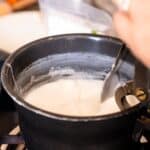Have you ever wondered what makes tallow soap so special? What is it about tallow that makes it perfect for soap making?

When it comes to soapmaking, tallow and lard are star ingredients. Tallow is a rendered form of beef or mutton fat. It is high in saturated fats and has a long shelf life. Tallow makes an excellent bar soap that is gentle and moisturizing on the skin.
If you are looking for a soap with rich goodness that will leave your skin feeling incredible, look no further than tallow soap! High-quality organic tallow soap is ideal for people who want to enjoy the benefits of using natural, handcrafted soap.
But first, we need to understand what tallow is and why we use it in our soap instead of oils. Our previous blogs talked about the different ingredients we can use to make exciting soaps, such as goat milk, lavender and oatmeals, olive oil, and some fruity soaps such as papaya soaps, etc. But, here, we will discuss tallow and why it is such a wonderful ingredient to use in soap.
So, what is tallow?
Since they were plentiful and inexpensive, our pioneer forefathers used tallow (rendered fat from cattle) and lard (rendered fat from pigs). It makes sense to put it to use; otherwise, it would just go in the garbage.
Tallow is a beautiful, white, solid fat extracted from the fatty tissues of cows, sheep, or other animals. People all over the world have used tallows for centuries in the making of soap. It is high in saturated fats, making it an excellent ingredient for soap making.
Tallow is one of the old-fashioned ingredients to make soap. Beef fat or tallow has many benefits that make it perfect for soapmaking.
Tallow Soap
Tallow soaps are amazing for your skin! They are super fattening and help to lock in moisture. Tallow is also great at cleansing the skin and removing dirt and oil. It has been used for centuries as a natural way to care for the skin.
During soap making, a chemical reaction occurs between the fat and alkaline substance. Same as, we make fed tallow soaps by combining animal fat with sodium hydroxide, commonly known as lye.
Lye is very corrosive, but it undergoes a chemical process known as saponification when combined with tallow. As a result of this mixing, a salt sodium tallowate forms.
Some folks believe that animal fat soap has an unusual odor or is greasy to the touch. However, the finished product should be odorless or have a mild fatty fragrance if done correctly.
Why use tallow for soap making
I wonder, does tallow soap have a place in the modern world? Or is it something that belongs in the past?
I decided to do some research on the subject and discovered that tallow soap is making a comeback! People are rediscovering the benefits of using this old-fashioned soap and are using it to produce high-quality soap products.
Tallow is a beautiful ingredient for soap making because it produces the hardest bar and leaves your skin feeling soft.

Amazing skin health benefits of tallow soap
Here are some reasons why tallow soap is good for your skin:
Foamy Leather:
Tallow creates a lovely, dense, white lather that is very moisturizing. It's also known to be less drying than other soaps.
Sustainability:
Tallow is a by-product of the beef industry. It will otherwise go to waste if it isn't used to make soap. So, by using tallow soap, you are helping to reduce waste.
Non-Allergenic:
Tallow is an excellent choice for people with sensitive skin. It is a natural product and doesn't have any harsh chemicals or artificial fragrances that cause allergic reactions.
Low Cost:
Tallow or beef fat is a very inexpensive ingredient, so you can make a high-quality tallow soap bar without spending a lot of money.
Long-lasting:
Tallow soap bars last a long time. They don't turn goop in water like glycerin soaps, and they don't dissolve quickly in water. So, they are a great value for your money.
Where can you buy organic tallow or lard for homemade tallow soap bars?
You can find tallow or lard at your local butcher shop, grocery store, or online. If you're using tallow, make sure it's from a grass-fed cow for the best quality. The quality of grass-fed tallow soap is much higher than that of grain-fed tallow soaps. Kidney fat is the best part to choose because it has the highest saturated fat content. This will give your soap a longer shelf life and more bubbles.
To make a premium quality grass-fed tallow soap, you must use high-quality ingredients. I use a 50/50 ratio of tallow and olive oil for the soap base. You can also use all tallow, but I find the 50/50 mix makes a nice, hard tallow soap bar with good lather.
How To Make Tallow Soap bar
Here's a little known fact about me: I love making my own soap. It's not only fun, but it also saves me money in the long run. And as a bonus, I get to control the quality of the ingredients that go into my soap.
You can make pure tallow soap using only tallow, water, and lye. Like in old times, some people used to make soap this way. Another way is to add other oils to the tallow soap recipe, like olive oil, palm oil, or coconut oil. Adding other oils will give your soap different properties, like more lather or moisturizing abilities. We will make natural soap with both recipes.
So, are you ready to learn how to make tallow soap?
Pure Tallow Soap Recipe:

Here's what you'll need:
- Beef fat or tallow or lard (I prefer beef tallow)-30 0z
- Lye (sodium hydroxide)-3.88 oz
- Distilled Water-11 0z
Instructions:
Tallow soap making is not complex, but you must follow the instructions, exactly-especially when working with lye, because it is a dangerous chemical.
First, you need to render the organic tallow. This means that you need to melt down the fat and remove all the impurities. I like to use a crockpot because it is slow and gentle, but you can also use a double boiler.
The second step is mixing lye and water. Don't forget to add the lye to the water; never add water to the lye. Carefully add lye into the water while stirring. Never breathe in the fumes that will come up from the mixture.
Always do this step in a well-ventilated area and wear safety goggles and gloves.
Stir until the lye has dissolved. When the lye and water come into contact, there will be a chemical reaction, and the water will become extremely hot, so handle it with care.
Keep this lye water in a safe place while it cools. It will take about an hour to cool down to room temperature.
Once the mixture reaches low temperature, you can start to pour the lye water into the melted tallow while stirring slowly.
It's better to use a stick blender or immersion blender for this step, but you can also use a hand mixer. Be sure to mix well so that the soap is consistent.
Mix the soap until it has thickened and reached a light trace. This will take about 15 minutes.
Cooking the soap:
Now, leave it to simmer for another 45-60 minutes.
The mixture will start to thicken and froth. Keep an eye on it and stir occasionally.
After 45-60 minutes, the soap becomes slightly thick. You can test the mixture by spooning a little bit of the soap onto a plate. If it sets up and doesn't melt quickly, it means the soap is ready.
Maybe there are any bubbles on the surface of the soap; you can lightly blow on them or use a spatula for popping them. You can also add any essential oil for scent at this phase if you like. ( I prefer lavender oil)
Now, it's time to pour the soap into the soap mold. You can use silicone molds, loaf pans, or anything else that you have on hand.
I like to use a silicone loaf pan because it makes it easier to store and use a smaller soap bar.
Allow the tallow or lard soap to cool and harden for 24 hours. Finally, you can remove it from the soap mold and cut it into bars.
To cure the lard soap, you must let it dry for at least 1-2 weeks. This allows the water to evaporate and makes the soap harder and longer-lasting.
So, there you have it! Your very own tallow soap or lard soap recipe.
Now, let's look at a recipe that includes other oils.
Basic Tallow, Olive Oil, and Coconut Oil Recipe
Some of the most popular tallow soaps recipes you'll come across include a little bit of tallow and a variety of vegetable oils. Because tallow has a limited cleaning capability on its own, it is frequently used with other oils.
When you make soap with pure tallow, it will have a minimal lather. This is why many recipes that include tallow also include other oils, like olive oil or coconut oil, which produce a more luxurious lather.
Another reason is that tallow is an inexpensive ingredient, so you can enjoy some luxury items such as cocoa butter, shea butter, or palm oil without breaking the bank.

For this recipe, you'll need:
- Beef Tallow or lard-500g
- Coconut oil-250g
- Olive oil-250g
- Caustic soda ( lye or sodium hydroxide)-142g
- Distilled Water-300 ml
- Essential oil (optional)-1-2 tsp
Instructions:
My advice for beginner soapmakers is to use a digital scale to weigh the ingredients instead of measuring them by volume. Different oils have different densities, so it's essential to measure them by weight to measure them accurately.
In addition, you must read the safety precautions for making soap, which we previously described in our blogs. Especially when working with lye, it is essential to take all necessary precautions to avoid injury.
Now that you have all ingredients and safety gear gathered, let's get started!
It's a cold-process soap recipe, so you don't need to cook it for long.
First, you'll need to render the tallow (or lard) down into liquid form. You can do this by slowly melting it over low heat on the stovetop, or you can use a crackpot.
Next, measure out the coconut oil and olive oil. Add both oils to the tallow, and stir until they are thoroughly combined.
Now it's time to make the lye solution. Carefully add the caustic soda to the water. Stir until the lye has dissolved, then set it aside to cool for a few minutes. When it reaches about 140 Fahrenheit, it is ready to add to the soap pot.
Slowly pour the lye water into the soap pot, stirring constantly. If you are using an immersion blender, this is a great time to use it. Keep stirring until the mixture becomes thick and reaches a trace. This cooking process will take about 30-40 minutes.
At this point, you can add any essential oil or other additives. Stir until they are evenly distributed, then pour the soap into the soap mold.
Allow the soap to harden for 24-48 hours, then cut into bars and allow to cure for at least four weeks. Enjoy!
Tallow soap smell :
Tallow soap can have a strong smoky smell when first made. The reason is the high percentages of animal fats used in the recipe. However, this scent will dissipate over time, and you gain beautiful, natural soap that has all of the benefits of tallow without the strong scent.
Beef tallow soap has a less smoky smell than other tallow soap or lard soap. Try to get fats from grass-fed animals whenever possible. Tallow from grass-fed beef is the best option for making soap because it has a milder smell and is also high in CLA (conjugated linoleic acid), a healthy fat that has many benefits for the skin.
Use of essential oils:
You can also add essential oils to your tallow soap recipe. Lavender, rosemary, and tea tree oil are all great options for soap making. They have cleansing and healing properties that make them ideal for use in soap. You can add as much or as little essential oil as you like, but generally, a ratio of one teaspoon per pound of tallow is sufficient.
Amount of fat in pure tallow soap:
You can make tallow soap with 100% pure tallow, which means it is a very rich and moisturizing soap. Tallow is composed of fatty acids that are very similar to the fats found in our skin, so it is an excellent choice for people with dry or sensitive skin.
Pure grass-fed tallow soap has 8% super fat. It means that there is an excess of fat in the recipe, which helps to moisturize and protect the skin. At the same time, tallow soap with coconut oil and olive oil combination enriches with a 6% superfat.
This recipe is suitable for people with oily skin or who live in humid climates. The extra fat in tallow soap helps balance the skin's natural oils and keeps the complexion from looking too oily.
FAQs about tallow soap
1. Which kind of tallow is good to use in skincare products?
The best tallow for soap making and other body care products is organic or fed beef tallow. Grass-fed beef tallow soap is high in omega fatty acids and has a wonderful natural scent. Some most popular brands use beef tallow to make face masks, lip balm, and commercial soap. Most skincare products contain beef tallow for their nourishing properties.
2. Why are tallow soaps good for sensitive skin?
Tallow soaps are good for sensitive skin because they are gentle and moisturizing. In addition, they don't contain any fancy ingredients or fragrances that can irritate the skin. The absence of essential oil and color dye makes this natural soap perfect for sensitive skin.
3. What is stearic acid, and how does it play an essential role in soap making?
Stearic acid is a saturated fatty acid present in animal and vegetable fats. It is a white, waxy solid that is insoluble in water. Stearic acid hardens the soap bar and gives it a creamy lather in homemade soap. Besides, many brands use stearic acid in skincare products such as lip balm, face masks, and other body care products.
4. Is tallow also good in making organic balm?
Organic balms are prepared with a combination of organic wax, oil, and butter. Tallow is also used as one of the ingredients in an organic balm. It is a good choice because it is natural, has a long shelf life, and is affordable.
In addition to tallow, you can also use coconut oil, olive oil, or shea butter in your organic lip balm.
5. What is the shelf life of tallow soap?
The shelf life of tallow soap is about two years. This means that you can store the soap at room temperature for a long time. However, it is best to store the soap in a cool, dry place. This will help keep the soap from melting and prolong its life.
The tallow soap is a great choice for those who want to make their soap at home. It is a natural product that is gentle on the skin and has a long shelf life. In addition, it is affordable and easy to make. Give it a try today!
6. What's the difference between Castile soap and regular soap?
Castile soap is similar to regular soap, but it's a great deal more environmentally friendly. It has vegetable oils, whereas regular soap is often made with beef tallow, lard, or other animal fats. This makes Castile soap a vegan product. In addition, Castile soap is biodegradable and doesn't pollute the environment like commercial soap can. Finally, Castile soap is gentle on the skin and doesn't contain harsh chemicals.
EndNote:
Making my soap at home with high-quality ingredients is very important to me. I love to do experiments with ingredients, and I'm always searching for the best ones to use. Tallow is one of those ingredients!
The regular reader of my soap blog knows that I am a big fan of using natural ingredients and nourishing ingredients for the skin. Instead of using fancy synthetic ingredients, expansive essential oils, and daunting ingredients, I prefer to stick to simple, natural ingredients like tallow.
Tallow falls into that category. This star ingredient has a long history of being used in soaps and other body care products. You will often see it listed as an ingredient in lip balms, face masks, and other skincare products.
In addition to being a great natural ingredient, tallow is also affordable. This means that you can make high-quality soap without spending a lot of money. So, enjoy making tallow soap with high-quality ingredients, and don't forget to leave a comment below to let me know how it turns out!
Happy soap-making! :)"


